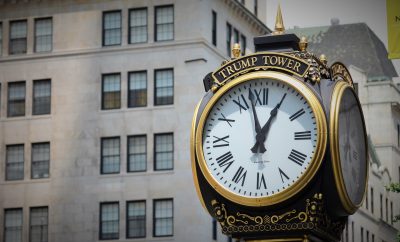 Image courtesy of Kevin Rizzo for Law Street Media
Image courtesy of Kevin Rizzo for Law Street Media
Crime
Is the World as Scary as Donald Trump Says it is?
On Thursday night, Donald Trump formally accepted the Republican nomination for president in Cleveland. In his acceptance speech Trump made one thing abundantly clear: he promises to be the law and order candidate. But with that promise came the need for justification: why do we need a law and order president? Trump sought to answer that question and more by painting a particularly bleak picture of America.
Let’s take a closer look at some of Trump’s claims and put them in some much-needed context. The quotes below are taken from his prepared remarks obtained by Politico Thursday afternoon. The transcript is nearly identical to the actual speech but may have some slight differences.
Where are our violent crime numbers?
Donald Trump started his speech with some stark claims about crime in the United States:
Homicides last year increased by 17 percent in America’s fifty largest cities. That’s the largest increase in 25 years.
The 17 percent claim appears to come from a Washington Post analysis that was published earlier this year. The Post looked at preliminary crime data from 50 of the largest American cities and found that murders increased by about 17 percent in 2015. So yes, it does appear that there is an increase in homicides and there may even be an uptick in violent crime–we’ll know for sure when the FBI releases its formal statistics this fall. But it’s also important to keep this development in context.
Even with a few years of a crime spike, America is much safer than it was a two decades ago. In fact, the violent crime rate has dropped precipitously over the last 25 years. As the chart below shows, the violent crime rate has dropped by about 43 percent between 1995 and 2014. While we don’t have more recent data, it is particularly unlikely that we have reversed many of those gains within the last year and a half. We may be experiencing a spike in violent crime right now, but we currently have no indication that it will lead to a multiyear trend of increasing crime rates.
The chart below shows how violent crime has dropped over the past several decades. Note that the Y-Axis does not start at zero, rather it starts at 300 to better illustrate the relationship between each point.

Source: FBI Uniform Crime Report
Trump specifically spoke about murder rates, which have also fallen in a similar fashion. In 1995 there were 8.2 murders per 100,000 people. In 2014 the rate was 4.5. The uptick identified by the Washington Post is certainly troubling, but that too must be taken in context. Trump accurately characterized the 17 percent spike as the largest change in the past 25 years. But as the Post points out, last year’s homicide rate remains below where it was in 2008 and not every city saw an increase. Of the largest 50 cities, 36 saw an increase in murders while 14 experienced a decrease or no change.
What about Chicago?
Trump went on to note that the number of shootings in Chicago is particularly high this year:
In the President’s hometown of Chicago, more than 2,000 have been the victims of shootings this year alone. And more than 3,600 have been killed in the Chicago area since he took office.
This statistic also appears to be true. According to the Chicago Tribune’s count, there have been 2,224 shooting victims between the beginning of the year and July 22. Last year there was 2,988 shootings in total, meaning that this year will likely surpass that final count.
There does appear to be a real problem with gun violence and homicides in many American cities. We do not have enough data to say whether this is a durable trend or just an uptick, but even accounting for an increase, violence remains near historic lows. We also don’t know what is responsible for the recent developments, as many competing theories have been thrown around. It is a complex and multifaceted problem that many local police departments will need to address.
Police in America
Trump also argued that law enforcement deaths are increasing:
The number of police officers killed in the line of duty has risen by almost 50 percent compared to this point last year.
According to the Officer Down Memorial page, which tracks police deaths as they happen, there have been 68 police officers killed in the line of duty so far this year, a 1 percent decrease. The National Law Enforcement Memorials Fund also keeps an independent count of officer deaths. According to the NLEMF’s data, there were 63 officer deaths at this point last year and there are 67 this year–a 6 percent increase. Both of those total counts include accidental deaths, but they also note that firearm-related deaths are up in 2016. A large part of that increase came in two recent high-profile attacks on police in Dallas, Texas and Baton Rouge, Louisiana.
After the Dallas attack, we noted that the resulting five officers deaths amounted to about 10 percent of the previous year’s total. According to preliminary numbers from the FBI, which specifically tracks felonious deaths, there were 42 officers killed in 2015. While the next round of FBI statistics on officer deaths and assaults in the line of duty will be particularly useful to inform these debates, the general trend has been going downward. For more, you can read our article titled, “What We Know About Officer Deaths in the Line of Duty”
Donald Trump went on to make several additional claims in his speech that have since been rigorously fact-checked. While Trump’s crime-related claims are directionally accurate, it is important to look at the surrounding context. Much of Trump’s speech seemed to hinge on whether or not the rule of law is breaking down in the United States. He argues that it has and that is why he is campaigning as the law and order candidate. However, despite a recent spike in murders and possibly violent crime, those rates remain near modern lows. Similarly, the number of police officers killed and assaulted has been declining over the past several years. While some of that progress may have been reversed temporarily, it’s important to ask whether that represents a durable trend or if it is simply a temporary uptick.








Comments